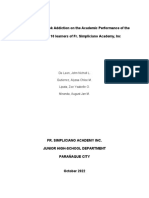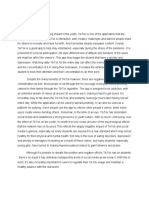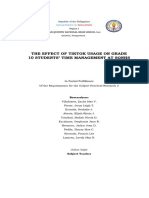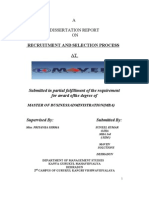0 ratings0% found this document useful (0 votes)
R&W Output 3
R&W Output 3
Uploaded by
Christa DiosantaTikTok can be used as a tool in the classroom to engage students in a fun and creative way through short videos. It allows students to become influencers by promoting school events and sharing ideas between schools. However, TikTok also has risks as students may become addicted to spending hours watching videos or creating inappropriate content. Educators should monitor student TikTok use and discuss safe and responsible online behavior if allowing the app in the classroom.
Copyright:
© All Rights Reserved
Available Formats
Download as DOCX, PDF, TXT or read online from Scribd
Download as docx, pdf, or txt
R&W Output 3
R&W Output 3
Uploaded by
Christa Diosanta0 ratings0% found this document useful (0 votes)
TikTok can be used as a tool in the classroom to engage students in a fun and creative way through short videos. It allows students to become influencers by promoting school events and sharing ideas between schools. However, TikTok also has risks as students may become addicted to spending hours watching videos or creating inappropriate content. Educators should monitor student TikTok use and discuss safe and responsible online behavior if allowing the app in the classroom.
Original Description:
hjkhjkhkj
Original Title
R&W OUTPUT 3
Copyright
© © All Rights Reserved
Available Formats
DOCX, PDF, TXT or read online from Scribd
Share this document
Did you find this document useful?
Is this content inappropriate?
TikTok can be used as a tool in the classroom to engage students in a fun and creative way through short videos. It allows students to become influencers by promoting school events and sharing ideas between schools. However, TikTok also has risks as students may become addicted to spending hours watching videos or creating inappropriate content. Educators should monitor student TikTok use and discuss safe and responsible online behavior if allowing the app in the classroom.
Copyright:
© All Rights Reserved
Available Formats
Download as DOCX, PDF, TXT or read online from Scribd
Download as docx, pdf, or txt
0 ratings0% found this document useful (0 votes)
R&W Output 3
R&W Output 3
Uploaded by
Christa DiosantaTikTok can be used as a tool in the classroom to engage students in a fun and creative way through short videos. It allows students to become influencers by promoting school events and sharing ideas between schools. However, TikTok also has risks as students may become addicted to spending hours watching videos or creating inappropriate content. Educators should monitor student TikTok use and discuss safe and responsible online behavior if allowing the app in the classroom.
Copyright:
© All Rights Reserved
Available Formats
Download as DOCX, PDF, TXT or read online from Scribd
Download as docx, pdf, or txt
You are on page 1/ 2
Diosanta Christa Jaymielitz F.
STEM-Bonifacio
Tiktok usage for students classroom purposes
TikTok is social media app. It lets users to make and edit three-to-15-second videos,
as well as thread together recordings up to 60 seconds long.However, this is only true when
videos are recorded within the app; footage uploaded from other sources can be much
longer. Tiktok platform is designed for making music videos, lip-sync videos, dancing videos,
and comedy shorts, but it may be used for anything. TikTok in the classroom doesn't have to
be a distraction that's outlawed when it can actually be a valuable tool for reaching and
engaging students on a deeper and more meaningful level. While the social networking
component of TikTok, which is exposed to the internet, needs to be kept under check the
video production side of the program may be a wonderfully creative tool in the teaching
toolkit.
Students are likely to spend a long time in the app due to the "endless stream" of content,
and may even grow addicted to watching videos for hours at a time. Some students make fun
of each other's movies, while others create videos solely to mock their classmates. To gain
more likes and followers, some kids create absurd, sometimes deadly, films. Although social
media challenges are a convenient method to acquire likes, some of them are inappropriate
for tweens and teens. According to some experts, it's simple to come across triggering
content on the app that could encourage self-harm or eating problems. Unsurprisingly, many
young individuals find the desire to become TikTok famous alluring. A user can become an
overnight viral phenomenon, attract thousands of new followers, and potentially jumpstart
their career with just one video. The appeal of TikTok shows no signs of waning in the age of
the influencer (indeed, some celebrities have active TikTok accounts). Given that Generation
Z dominates TikTok's user base, this has clear consequences for education. Despite the fact
that many schools prohibit the use of cellphones in the classroom, 90 percent of British
youngsters have their own smartphone by the age of 11. Furthermore, 90 percent of the 500
million active TikTok users around the world use the app multiple times every day. On
average, users spend 52 minutes per day on the site and open it eight times per day. TikTok
has a high level of engagement, which some educators feel is detrimental to education.
TikTok's content provides instructional tips and takeaways in a pleasant and engaging
fashion, teaching something useful and driving people to seek out more information. But
when you break it down into pieces and consequences, it's not so difficult. It's even been
dubbed the "future of education" by Fast Company. Even if that turns out to be a lot of
hyperbole, the lessons of video and social interactions, as well as digital media, are hard to
dismiss as part of that future. Unique science experiments, valuable life hacks, clever math
tricks, easy DIY projects, and inspiring messages and advice have all piqued the interest of our
community. We're continuing to develop creators and partnerships that support this type of
content on the platform with our Creative Learning Fund." TikTok's social media platform
style allows students to become "influencers," which encourages students to engage in the
community. For example, have students create videos about upcoming sports events, musical
and dramatic productions, science fairs, dances, and other happenings. This not only
promotes school events, but it also allows the school to be featured on a district-wide
platform. Other schools can obtain and exchange ideas as well, all while engaging and
fostering kids' creativity.
Finally, TikTok is a fun and creative platform where users can share dance videos, tell
humorous jokes, and showcase their skills. However, some of the information posted by
users may include explicit language, suggestive themes, and sexual gestures.If you let your
pupils to use the TikTok app, Sensible Social suggests using the program's Family Pairing
option and talking with them about safe and smart social media activities.
You might also like
- McGee-Warms - Anthropological Theory 6eNo ratings yetMcGee-Warms - Anthropological Theory 6e28 pages
- The Effects of Tiktok Addiction On The Academic Performance of The Grades 9 and 10 Learners 2 1 1 1100% (6)The Effects of Tiktok Addiction On The Academic Performance of The Grades 9 and 10 Learners 2 1 1 113 pages
- Living in A Moment: Impact of Tictok On Influencing Younger Generation Into Micro-FameNo ratings yetLiving in A Moment: Impact of Tictok On Influencing Younger Generation Into Micro-Fame5 pages
- We Live in A Time and Age Where Information Is Just A Button Press AwayNo ratings yetWe Live in A Time and Age Where Information Is Just A Button Press Away2 pages
- the art of making viral video for international studentNo ratings yetthe art of making viral video for international student16 pages
- The Influence of TikTok On The Level of SelfNo ratings yetThe Influence of TikTok On The Level of Self2 pages
- The Influence of Tiktok Contents in Childrens Cognitive DevelopmentNo ratings yetThe Influence of Tiktok Contents in Childrens Cognitive Development9 pages
- The Ultimate TikTok Handbook: 30 Chapters for Teenage Content CreatorsFrom EverandThe Ultimate TikTok Handbook: 30 Chapters for Teenage Content CreatorsNo ratings yet
- The Impact of TikTok On Students A Literature ReviNo ratings yetThe Impact of TikTok On Students A Literature Revi8 pages
- Green and Purple Playful Illustrative Social Media Brainstorm Presentation_20241008_065906_0000No ratings yetGreen and Purple Playful Illustrative Social Media Brainstorm Presentation_20241008_065906_00008 pages
- TikTok Marketing: Best practices for your business on the TikTok PlatformFrom EverandTikTok Marketing: Best practices for your business on the TikTok Platform5/5 (2)
- TikTok Has Swiftly Risen To Prominence As One of The WorldNo ratings yetTikTok Has Swiftly Risen To Prominence As One of The World1 page
- The Effects of Social Media To The Academic Performance of Senior High School Students of Immaculate Conception Academy During The Covid-19 Pandemic100% (1)The Effects of Social Media To The Academic Performance of Senior High School Students of Immaculate Conception Academy During The Covid-19 Pandemic15 pages
- Infusing Critical Thinking Into An Employability Skills ProgramNo ratings yetInfusing Critical Thinking Into An Employability Skills Program380 pages
- Moore M. S., The Interpretative Turn in Modern Theory, 1988No ratings yetMoore M. S., The Interpretative Turn in Modern Theory, 198889 pages
- National Education Policy 2020 and Higher Education: A Brief ReviewNo ratings yetNational Education Policy 2020 and Higher Education: A Brief Review5 pages
- Employment Opportunities For Nys Graduates Abroad (Middle East)No ratings yetEmployment Opportunities For Nys Graduates Abroad (Middle East)7 pages
- Latihan Penilaian Akhir Semester Nama: Kelas: 5 Pelajaran: Bahasa InggrisNo ratings yetLatihan Penilaian Akhir Semester Nama: Kelas: 5 Pelajaran: Bahasa Inggris2 pages
- M Channon Resume 2023 For Weebly - MchannonNo ratings yetM Channon Resume 2023 For Weebly - Mchannon3 pages
- CV - Maurice Burnett Current at 2022-11-09 PDFNo ratings yetCV - Maurice Burnett Current at 2022-11-09 PDF3 pages
- Detailed Lesson Plan in English Grade 3 - FINAL DLP FOR COTNo ratings yetDetailed Lesson Plan in English Grade 3 - FINAL DLP FOR COT5 pages
- Anesthesia Administration Assembly ConferenceBrochure - MGMANo ratings yetAnesthesia Administration Assembly ConferenceBrochure - MGMA20 pages
- International Journal of Education Research For Higher Learning Print ISSN 1656-0604 Vol. 24 No. 2 October 2018 Online ISSN 2244-6532No ratings yetInternational Journal of Education Research For Higher Learning Print ISSN 1656-0604 Vol. 24 No. 2 October 2018 Online ISSN 2244-65325 pages
- Daily Lesson Plan in Understanding Culture Society and PoliticsNo ratings yetDaily Lesson Plan in Understanding Culture Society and Politics6 pages





























































































